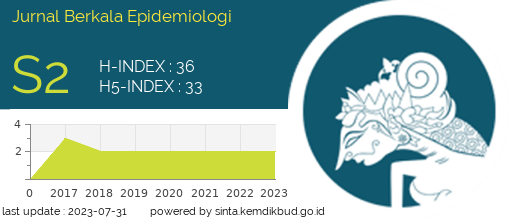A Descriptive Study about Factors Affecting Data Quality of EWARS in Surabaya 2016
Downloads
Early Warning Alert and Response System (EWARS) is a health information technology that is used for recording and reporting diseases especially those that have the potential to cause outbreaks and can produce "alerts" if an outbreak indication is found in an area. EWARS reporting is carried out on a weekly basis by reporting disease data on the EWARS website according to the code of each predetermined disease. This research is a descriptive study with a quantitative approach. The sampling technique uses simple random sampling. Interviews were conducted with 33 EWARS officers at the Public Health Center (PHC) in Surabaya using a questionnaire. Research variables are staff characteristics including age, gender, level of education, length of work, experience using the computer, and the experience of obtaining EWARS socialization as well as the level of knowledge, attitudes, perceptions of ease, and perceived usefulness of officers regarding the implementation of EWARS, and the quality of EWARS report data at Surabaya City in 2016. The results of this study indicate that the majority of respondents are aged 20-40 years, are female, have an adequate level of education, have worked as EWARS officers for more than 2 years, have used computers for more than 2 years, and the majority had received EWARS socialization. Most respondents have a good level of knowledge, attitudes, and perceptions of ease and usefulness of technology regarding the implementation of EWARS, but the quality of the data produced is of poor quality. The conclusion of this study is the level of knowledge, attitudes, perceptions of ease, and the perception of usefulness is good but it doesn't follow by a quality EWARS report. EWARS reports that are sent in full and on time are not necessarily of quality because there are still other attributes that need to be measured.
Alloghani, M., Hussain, A., Al-Jumeily, D., Abuelma'atti, O. 2015. Technology Acceptance Model for the Use of M-Health Services among health related users in UAE. 2015. Tersedia di: http://ieeexplore.ieee.org/document/7563640/ [Sitasi 10 Juli 2017].
Evaluasi Penerapan Sistem Informasi Surveilans Berbasis EWARS dalam Upaya Deteksi Dini Kejadian Luar Biasa di Kabupaten Barru. Tesis. Fakultas Kedokteran Universitas Gadjah Mada Yogyakarta.
CDC. 2001. Updated Guidelines for Evaluating Public Health Surveillance Systems. Tersedia di: https://www.cdc..gov/mmwr/preview/mmwrhtml/ rr5013a1.htm.MMWR 2001; 50 (RR-13): 1-35. [Sitasi 12 Juli 2017].
Chow M, Chan L, Lo B, Chu WP, Chan T, Lai YM. Exploring the intention to use a clinical imaging portal for enhancing healthcare education. Nurse Education Today [Nurse Educ Today] 13 Februari 2012. Date of Electronic Publication: 13 Februari 2012.
Davis, F.D. 1989. Perceived Usefulness, Perceived Ease of Use and User Acceptance of Information Technology. MIS Quarterly.
Depkes RI. 2008. Pedoman Sistem Kewaspadaan Dini dan Respons. Jakarta: Departemen Kesehatan Republik Indonesia.
Depkes RI. 2012. Pedoman Sistem Kewaspadaan Dini dan Respons. Jakarta: Departemen Kesehatan Republik Indonesia.
Dharmarajan, B., Gangadharan, K. 2013. Applying Technology Acceptance (TAM) model to determine the acceptance of Nursing Information System (NIS) for Computer Generated Nursing Care Plan among Nurses. International Journal of Computer Trends and Technology (IJCTT), Agustus 2013, Vol. 4 No. 8, hh. 2625-2628.
Dinas Kesehatan Kota Surabaya. 2016. Laporan Sistem Kewaspadaan Dini dan Respon (SKDR) Surabaya tahun 2016. Surabaya. Seksi Surveilans dan Imunisasi, Dinkes Kota Surabaya.
El-Wajeeh, M., Galal-Edeen, G.H., Mokhtar, H. 2014. Technology Acceptance Model for Mobile Health Systems. IOSR Journal of Mobile Computing & Application (IOSR-JMCA), Mei-Juni 2014, Vol. 1, No. 1, hh. 21-33.
Kepmenkes RI. 2003. Keputusan Menteri Kesehatan Republik Indonesia Nomor 1479/Menkes/Sk/X/2003 Tentang Pedoman Penyelenggaraan Sistem Surveilans Epidemiologi Penyakit Menular
Dan Penyakit Tidak Menular Terpadu.
Ketikidis, P., Dimitrovski, T., Bath, P., Lazuras, L. 2012. Acceptance of Health Information Technology in Health Professionals: An Application of the Revised Technology Acceptance Model. Health Informatics Journal, Juni 2012, hh. 1-7.
Kowitlawakul Y. 2011. The technology acceptance model: predicting nurses' intention to use telemedicine technology (eICU). Computers, Informatics, Nursing: CIN [Comput Inform Nurs], Juli 2011, Vol. 29 No. 7, hh. 411-8.
Kristiani, S.Y.M., Kusnanto, H., Probandari, A. 2016. Pengelolaan Informasi Early Warning Alert and Response System di Kabupaten Boyolali. Journal of Information Sytems for Public Health, Vol. 1, No. 1, April 2016, hh. 55-57.
Liu, C.F., Tsai, Y.C., Jang, F.L. 2013. Patients' Acceptance towards a Web-Based Personal Health Record System: An Empirical Study in Taiwan. International Journal of Environmental Research and Public Health, Oktober 2013, No. 10, hh. 5191-5208.
Ningsih, K.P., 2013. Hubungan Beban Kerja dan Kepuasan Kerja dengan Kinerja Karyawan di Instalasi Rekam Medis Rumah Sakit Mata "Dr. Yap” Yogyakarta. Skripsi. Fakultas Ilmu Kesehatan Universitas Muhammadiyah Surakarta.
Notoatmodjo, S. 2012. Promosi Kesehatan dan Perilaku Kesehatan. Jakarta: Rineka Cipta.
Palupi, R. 2015. Hubungan Persepsi Manfaat, Persepsi Kemudahan Penggunaan, dan Sikap Pengguna dengan Penggunaan Aktual Sistem Informasi Manajemen Rumah Sakit (SIMRS). Tesis. Program Studi Kedokteran Keluarga Universitas Sebelas Maret Surakarta.
Paramita, S. 2017. Analisis Pengetahuan, Sikap, serta Persepsi Kemudahan dan Kemanfaatan Teknologi tentang Penerapan EWARS dengan Kualitas Data EWARS di Kota Surabaya. Skripsi. Fakultas Kesehatan Masyarakat Universitas Airlangga.
Priyontika, B., Wahjudi, P., Prasetyowati, I. 2016. Early Warning Alert and Response System (EWARS) sebagai Upaya Deteksi Dini Kejadian Luar Biasa (KLB) di Puskesmas Kabupaten Jember. Artikel Ilmiah Hasil Penelitian Mahasiswa 2016, hh. 1-4.
Stocker, G. 2010. Technology acceptance of electronic medical records by nurses. Disertasi. Webster University; D.Mgt. (84 p).
Sutarman. 2008. Faktor-faktor yang Berhubungan dengan Keterlambatan Petugas dalam Menyampaikan Laporan KLB dari Puskesmas ke Dinas Kesehatan (Studi di Kota Semarang). Tesis. Program Studi Epidemiologi Universitas Diponegoro Semarang.
Thenu, V.J., Sediyono, E., Purnami, C.T. 2016. Evaluasi Sistem Informasi Manajemen Puskesmas Guna Mendukung Penerapan Sikda Generik Menggunakan Metode Hot Fit di Kabupaten Purworejo. Jurnal Manajemen Kesehatan Indonesia, Vol. 4, No. 2, Agustus 2016, hh. 1-2.
Wahyuni, A.S.R., Sidik, D., Wahiduddin. 2012. Gambaran Pelaksanaan Program Early Warning Alert and Response System (EWARS) di Puskesmas Kabupaten Gowa Tahun 2012. Artikel Ilmiah Hasil Penelitian Mahasiswa, hh. 1-6.
Wijaya, A.M. 2012. Data Quality Self Assestment (DQS) – Penilaian Mandiri Kualitas Data Rutin (PMKDR) Sistem Informasi Kesehatan.
Tersedia di:https://www.infordokterku.com/ index.php/en/82-daftar-isi-content/data/data/79-data-quality-self-assessment-dqs-atau-penilaian-mandiri-kualitas-data-rutin-pmkdr-atau-sistem-informasi-kesehatan. [Sitasi 12 Juli 2017].
- Every manuscript submitted to must observe the policy and terms set by the Jurnal Berkala Epidemiologi
- Publication rights to manuscript content published by the Jurnal Berkala Epidemiologi is owned by the journal with the consent and approval of the author(s) concerned. (download copyright agreement)
- Complete texts of electronically published manuscripts can be accessed free of charge if used for educational and research purposes according to copyright regulations.

JBE by Universitas Airlangga is licensed under a Creative Commons Attribution-ShareAlike 4.0 International License.























